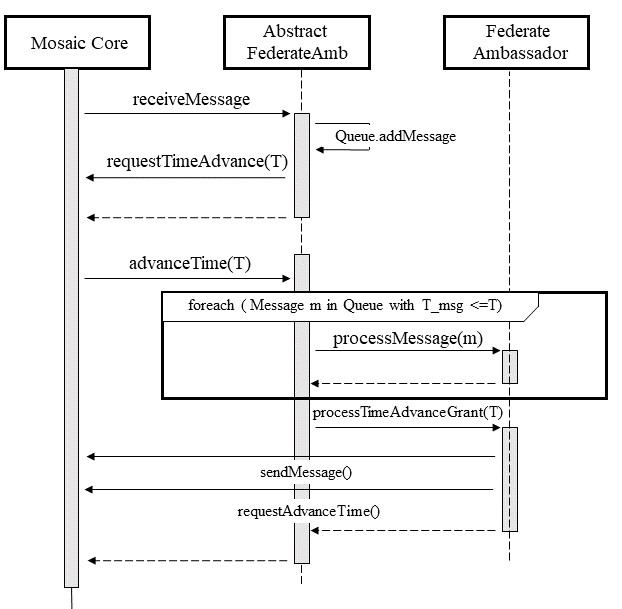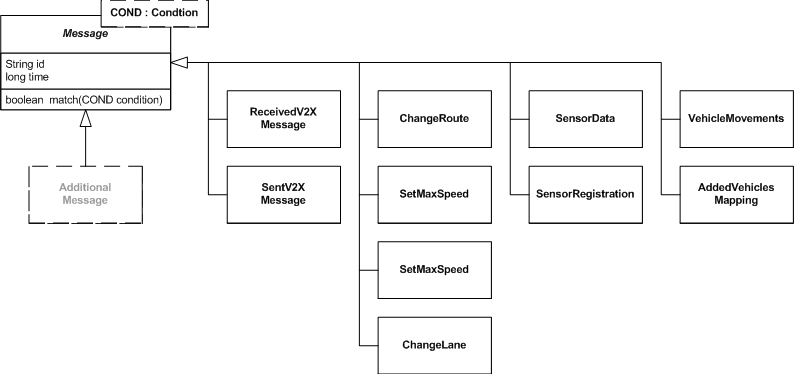Simulator Coupling
This section provides general information which helps to couple your own simulator with Eclipse MOSAIC. For a successful coupling, two parts are required: the Federate Ambassador is the communication interface between the RTI and your simulator. It implements predefined interfaces of the Eclipse MOSAIC core library and is directly coupled with Eclipse MOSAIC. Second, your simulator needs to communicate with the Federate Ambassador. For this purpose, you either need to implement your own protocol to control the simulator, or use existing ones of your respective simulator (e.g. SUMO provides the TraCI byte buffer protocol).
Implementing a Federate Ambassador
In order to simplify federate development and to make the usage of the mechanisms provided by the RTI
safer, an abstract class called AbstractFederateAmbassador is provided by the Eclipse MOSAIC core package.
It implements the FederateAmbassador interface and handles incoming interactions as well as time
advance grants according to the specified federate behaviour. When a federate implementation is making
use of the AbstractFederateAmbassador as a super class, it has to provide two information to the
superclass while constructing an instance of the class. These are:
-
isTimeConstrained: The general way this parameter can be understood, is that if it is set to true the federate is sensitive towards the time stamp order of interactions. TheAbstractFederateAmbassadorwill then queue incoming interactions and request a time advance from the RTI in order to ensure that processing the received interaction is safe. At the time the requested time advance is granted, every queued interaction with a time stamp smaller or equal to the granted time will be delivered to the federate for processing. If set to false, incoming interactions will be forwarded immediately to the federate, thus resulting in a receive-order of interactions at the federate. -
isTimeRegulating: Specifies whether the federate will publish time stamped interactions and thus can influence the time advances of other federates in the federation. If set to true, theAbstractFederateAmbassadorwill request time advances with respect to the specified lookahead value of the federate in order to avoid that time management schedules the execution of other federates while queued interactions are processed. If set to false, time advance requests that are issued due to incoming interactions will be flagged with an unlimited lookahead, allowing the RTI to schedule other federates while incoming interactions are processed.

Further notes
Coupling a multitude of different simulators and properly syncing them is a non-trivial task and requires a lot of effort in order to
function correctly. If you have read up on High Level Architecture before
(have a look
here and at the linked references) you might notice, that the
previous flowchart does not completely reflect the proposed mechanisms. For instance, the isTimeRegulating flag has no effect, when the
isTimeConstrained flag is not set.
So at some points you might stumble upon federates, which have their isTimeConstrained and isTimeRegulating flags set to different
values as you would expect. An example of this is the ApplicationAmbassador. One would expect it to be time-constrained as well as
time-regulating. This isn’t the case though, because the ApplicationAmbassador implements its own time- and event-management,
which would interfere with the internal mechanisms.
When implementing your own federate, you can use the existing ones as reference.
Example
A federate that is timeConstrained and timeRegulated can handle a time stamped interaction
only after receiving a corresponding time advance grant. For that reason, the AbstractFederateAmbassador
caches the incoming interactions in a local queue and requests a time advance with the interactions
time stamp. After getting a grant for that time stamp, it forwards the interaction via the processInteraction
method call and afterwards invokes processTimeAdvanceGrant to allow the federate to proceed in its
local simulation time. In the activity diagram in the following figure, the process of handling of incoming interactions
with respect to the federate configuration is illustrated.

Integration into Eclipse MOSAIC
The first step to integrate a new component is the extension of the configuration file etc/runtime.json.
An example for a federate configuration can be found in following listing.
"federates": [
...
{
"id": "omnetpp",
"classname": "org.eclipse.mosaic.fed.omnetpp.ambassador.OmnetppAmbassador",
"configuration": "omnetpp_config.json",
"configurationDeployPath": "omnetpp-federate/simulations",
"priority": 50,
"dockerImage": "",
"host": "local",
"port": 4998,
"deploy": true,
"start": true,
"subscriptions": [
"VehicleRegistration",
"RsuRegistration",
"TrafficLightRegistration",
...
],
"javaClasspathEntries": []
},
...
]
The following parameters are available:
-
class- Attribute giving the full qualified name of the Java class which implements the Feder- ateAmbassador interface. -
id- The id of the federate. This value should be as short as possible and will be also used for identifying the configuration folder within scenarios. -
deploy- If set to true, the federate placed under bin/fed/will be copied to the execution host (according to the host configuration file). -
start- If set to true, the federate will be started by the federation management using the start command specified in the configuration file or this implementation. -
subscriptions- A list of interaction names which the Federate Ambassador subscribes for. If any other ambassador sends out one of those interactions, this ambassador will receive them.
Interaction extension
Another possibility to extend Eclipse MOSAIC is to add a new interaction to the set of predefined interactions. In the following
figure, the abstract class Interaction, implemented interaction extensions, and a place holder for further
extensions (rectangles with grey fonts and a dotted border) are illustrated. When the InteractionManagement
forwards interactions among federates, it chooses the destination based on a interaction id and
an optional condition. Furthermore, it synchronizes the interaction delivery based on their times. The
abstract class Interaction offers these attributes but no further content. The exchanged content has to be
implemented by extending the class Interaction. The already implemented extensions cover the content
necessary to simulate common scenarios. However, for further scenarios further interactions might be
required.
